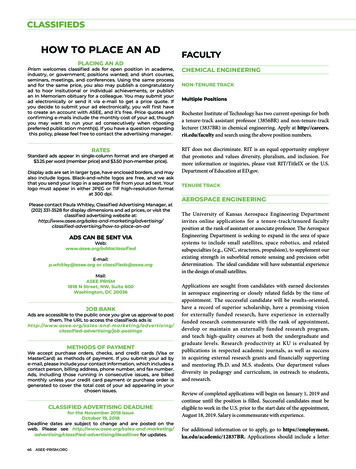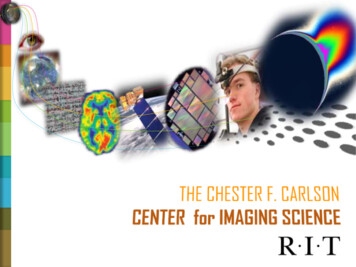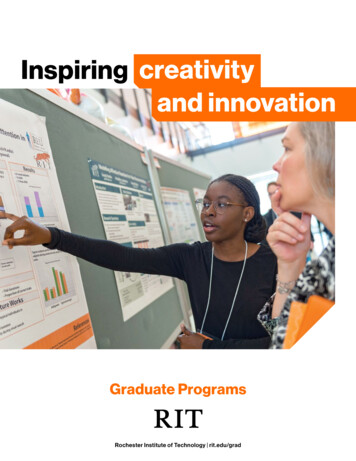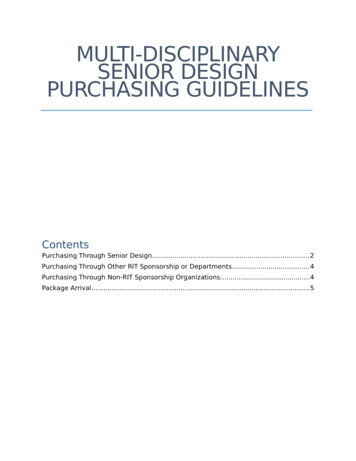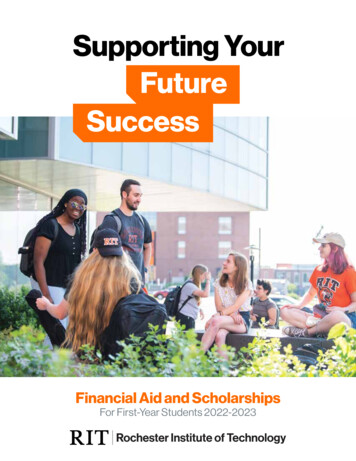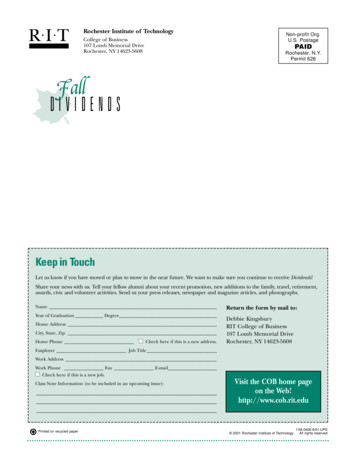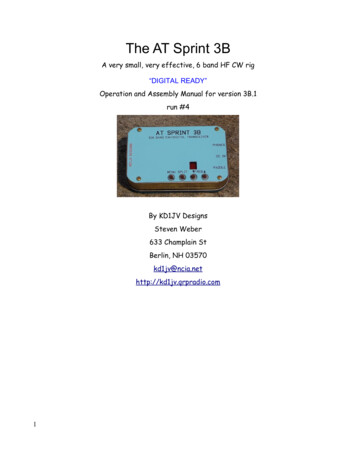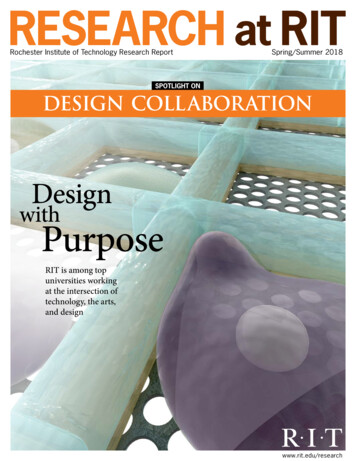
Transcription
RESEARCH at RITRochester Institute of Technology Research ReportSpring/Summer 2018SPOTLIGHT ONDESIGN COLL ABORATIONDesignwithPurposeRIT is among topuniversities workingat the inter section oftechnology, the arts,and designwww.rit.edu/research
Welcome A Letter from the Vice President for ResearchRESEARCH at RITThe Rochester Institute of TechnologyResearch Report–Spring/Summer 2018Strength in DesignPuts RIT in Right Placeat Right TimeExecutive EditorsRyne RaffaelleVice President for Researchand Associate ProvostJohn TrierweilerVice President and Chief Marketing OfficerManaging EditorBob FinnertyMarketing and CommunicationsEditorMindy MozerMarketing and CommunicationsDesign DirectorJeff ArbegastMarketing and CommunicationsContributorsMarketing andCommunicationsFreelance WritersScott BureauStacey FreedMichelle CometaKathy LindsleyRichard KileyFelicia SwartzenbergContributing PhotographersMarketing andCommunicationsElizabeth LamarkA. Sue WeislerOffice of Research Communications74 Lomb Memorial DriveRochester, NY 14623585-475-5094No. 2116M-P2088-4/18-BRO-JSA 2018 Rochester Institute of TechnologyAll rights reservedRochester Institute of Technology publishes Research at RIT.RIT does not discriminate. RIT promotes and values diversitywithin its workforce and provides equal opportunity to all qualifiedindividuals regardless of race, color, creed, age, marital status,sex, gender, religion, sexual orientation, gender identity, genderexpression, national origin, veteran status, or disability.No. 2, April 2018—RIT (USPS-676-870) is published 16 timesannually by Rochester Institute of Technology, One LombMemorial Drive, Rochester, N.Y. 14623-5603, once in March,once in April, once in May, four times in June, three times inJuly, four times in August, once in September, and once inNovember. Periodicals postage paid at Rochester, N.Y.14623-5603 and additional mailing offices. Postmaster: Sendaddress changes to RIT, Rochester Institute of Technology,One Lomb Memorial Drive, Rochester, N.Y. 14623-5603.RIT has found itself in the right place at the righttime on several occasions over its long history.I believe we find ourselves in a similar positiontoday with our strength in design.In nearly everyfield one canimagine, andsome that arejust emerging,the importanceof design hasnever beengreater. In allareas of manufacturing,software, graphicarts, and others,good designis recognizedas paramount and critical to success.This is indeed good news for RIT aswe possess what are arguably some ofthe best design programs in the world.Our programs in video game designand development and industrial designare regularly ranked globally. The 2015-16DesignSchoolsHub rankings recognizefour of RIT’s design programs: first forjewelry design, offered by the School forAmerican Crafts (SAC) in the College ofImaging Arts and Sciences (CIAS); fourthfor furniture design, also offered by SAC;fourth for video game design, offeredby the B. Thomas Golisano College ofComputing and Information Sciences;and ninth for industrial design, offeredby the School of Design in CIAS.This issue of Research at RIT willshine a light on some of the people andprograms that have contributed to all ofSpring/Summer 2018these high rankings and recognition.For example, students in RIT’s KateGleason College of Engineering’smultidisciplinary senior design programget a start-to-finish design-and-buildexperience similar to what they canexpect in industry.By partnering with industry, RIT’sindustrial design department’s Meta projectteaches students the role of researchat every stage of the design process.Through three collaborative courses—Packaging Development, PackagingDesign, and Senior Studio One—studentslearn how the design process in thepackaging industry works by creatingdesigns for a sponsoring company.And we showcase how student andfaculty researchers are working to changethe culture of computing in an effortto make technology accessible for all.I do hope that in perusing this issueyou will gain an appreciation of howgood design improves so manyaspects of our daily lives. I also hopeyou’ll learn more about how RIT istaking the lead in training the nextgeneration of great designers.Best regards,Ryne RaffaelleVice President for Researchand Associate Provost
Contents Inside this IssueInside this IssueFocus Areas2 - 312Research Fuels Ideasand Creativity that PowerRIT Designers10Senior design projects arethe practicum for designthinking. Students arelearning to develop real,human solutions usingmodern technologies.RIT’s design programs areworld ranked due toinnovative students andfaculty, along with close tiesto industry and alumni.16Metaproject LiftsStudent Designs toProfessional Level22RIT’s industrial designdepartment’s Metaprojectteaches students the roleof research at every stageof the design process.28RIT Experts Focus onUser-Centered Designto Make ComputingAccessibleResearchers are working tomake technology accessiblefor all by changing theculture of computing.Creating BetterPackaging DesignThrough Collaboration30coverWhat’s Old is New AgainThrough RemanufacturingRemanufacturing involvesa rigorous engineering processdesigned to return a worn ornonfunctional product to a“like-new” or “better-thannew” condition.Professors from packagingscience, graphic design,and industrial design areproviding their studentswith unique opportunitiesfor collaborative design.On the CoverStudents Solve Problemsin Senior Design ProgramResearch Awards and HonorsRIT’s medical illustrationprogram and its multidisciplinary connectionsexemplify why RIT is amongleaders at the intersectionof technology, the arts, anddesign. This microarrayimage of nanoporousmembranes is by graduatestudent Bradley Kwarta.Research at RIT32RIT’s faculty, staff, andstudents have receivedsignificant national andinternational recognition fortheir research in a host offields. A summary of awardsand honors is provided.1
Capturing Science: This image shows exosomes—small vesiclesproduced by stem cells—being isolated using a nanoporousmembrane. The scene was designed by Bradley Kwarta, a medicalillustration graduate student. Medical illustration’s multidisciplinaryconnections exemplify why RIT is among top universities working atthe intersection of technology, the arts, and design.
Focus Area Research Fuels Ideas and Creativity that Power RIT DesignersResearch Fuels Ideasand Creativity thatPower RIT Designersby Rich KileyRIT is one of the top universities in the nation workingat the intersection of technology, the arts, and design.The university’s design programs are world rankeddue to innovative students and faculty, along withclose ties to industry and alumni.From Beaux-Arts to ModernismDesigners thrive when they have aworking concept of what makes peopletick, a context that allows them to shapetheir ideas by considering what peoplecovet and use—along with a place tofocus all of their creative energy.What provides the fuel for suchnew ideas? Research.“Design research is foundationalto understanding and meeting humanneeds,” said ChrisJackson, associatedean of RIT’s Collegeof Imaging Arts andSciences (CIAS).“The informationgained through designresearch validatesChris Jacksonideas. It translatesassumptions into actionable knowledge.Applying this knowledge significantlyraises the bar on delivering a successfuldesign solution that resonates with users.”Design research emerged as arecognizable field of study at RIT andelsewhere in the 1960s. Some of theorigins of design research are found inthe emergence of operational researchmethods and management decisionmaking techniques after World War II,the development of creativity techniquesin the 1950s, and the early beginningsof computer programs for problemsolving in the 1960s.Research at RIT“When I first came to RIT in 1963,it was largely a beaux-arts school,” saidR. Roger Remington,RIT’s Vignelli Distinguished Professor ofDesign, referring tothe classical decorativestyle and influencesof Paris from theearly- to mid-1900s.R. Roger Remington “The change from afine arts school into one of modernistdesign precipitated the dramatic shiftfrom analog to digital and the adventof more intensive research here.”In 1983, Remington, the author of sixbooks on the history of graphic designwith two more in the works for 2018,organized “Coming of Age,” the first-everinternational symposium on the historyof design, with a particular focus ongraphic design. From those early roots,RIT has become a world leader inemphasizing history, theory, andcriticism in design education and research,including the acquisition of nearly 50archives of design’s modern masters.No other school or institution of anykind can offer such extensive opportunities to learn and research from actualartifacts, rather than reproductions,Remington observed.These resources complement RIT’swide variety of creative programs thatrely considerably on research, from3
Focus Area Research Fuels Ideas and Creativity that Power RIT DesignersGenerative Design: Designed by Alex Lobos,graduate director of industrial design, andindustrial design graduate student DavidVillarreal, this lamp represents research usingcomputer-aided design (CAD) to modelorganic forms in as few steps as possible,allowing the software to generate most of theshape. The lamp was modeled in AutodeskFusion 360 and milled out of wood with aShopbot CNC router.Sustainable Design: As an extended faculty member of the Golisano Institute for Sustainability(GIS), Alex Lobos, associate professor and graduate director of industrial design, noted thatresearching and designing “green” or environmentally benign products has become even moreimportant. Here he is leading a session with Callie Babbitt, an associate professor at GIS.industrial design, new media design,3D digital design, and interior designto the fine arts and crafts programs inglass, metal, wood, and ceramics.Design ‘Explosion’ Fuels Research“Design has always had this focus onapplying research as part of the visuallanguage and thevisual dialogue thatwe’re creating,” saidAdam Smith ’01(MFA computergraphics design),chair of the new mediadesign program andAdam Smithgraduate director ofvisual communication design. “Fifteenyears ago, design—especially interactivedesign—was very ad hoc. Here at RIT andelsewhere, designers were exploring newand different ways of using technologyto present information, so in a way earlydesign was a form of research.”4“What we lacked, however, in theearly days, was the ability to necessarilyunderstand how to leverage the powerof the research methodologies,” Smithadded. “There’s a method to analyze,to record and evaluate design researchand build those improvements off of it.”One benefit of the huge explosionin design over the last two decades isthat it has enabled designers to refineand hone ideas based on usability,usefulness, and functionality, accordingto Smith and other members of theRIT design faculty.“After we started to see things like theiPhone come out, companies like Appleand others were for the first timepublishing design guidelines around notjust visual styles but also how humansinteract with these devices,” he said.“That provided us a compass to takethis direction of interaction, visual design,and design language and place it underthe umbrella of research patterns.”Spring/Summer 2018User-Centered Research a KeyAlex Lobos, associate professor and graduatedirector of industrial design, noted thatresearch is essential to making the designprocess user-centered, iterative, and honest.“Research can be liberating to designersbecause it provides important detailson how users will respond or react to aproduct in a certain way, so it doesn’tall fall on the designer,” Lobos said. “Inaddition to being user-centric, good designhas to be iterative so designers can refinetheir ideas with each stage of the process.”As an extended faculty member of theGolisano Institute for Sustainability,Lobos noted that researching anddesigning “green” or environmentallybenign products has become even moreimportant in recent years, particularlyamong younger generations.“By minimizing waste in the researchand design process, you end up witha product that’s very honest and pure,”he said. “Today’s end user will react
Focus Area Research Fuels Ideas and Creativity that Power RIT DesignersNeonatal ICU: Interior designstudents researched andproposed interior packages fora campaign to significantlyexpand a neonatal intensivecare unit for Honduras’ largestpublic hospital. Mary Golden’sstudents are collaborating withLittle Angels of Honduras, anorganization dedicated toreducing infant mortality.Design research is enabling RIT studentsto solve real-world problems, accordingto Peter Byrne, administrative chair andprofessor in the School of Design.Capstone Research: Alexa Boyd, left, interior design; Hannah Lutz,industrial design; and Victoria Tripp, mechanical engineering, pose withDr. Armando Berlios of Hospital Escuela. They are working on capstoneresearch projects, led by Mary Golden, with Little Angels of Honduras.favorably to that because they canrecognize that honesty.”Lobos arrived at RIT eight years agofrom General Electric. Leveraging hisindustry background, he oversees multidisciplinary collaborations between RITand a number of partner companies,including Autodesk, the internationalsoftware company based in San Francisco.Since Lobos spearheaded RIT’srelationship with Autodesk in 2011,the research and design collaborationhas flourished.He has attended joint conferencepresentations with company executivesas part of Autodesk University, and thecompany has sponsored several multi disciplinary research projects that areopening new worlds for people througheffective access technology.RIT is one of only four universitiesAutodesk has signed a memorandumof understanding agreement with towork together even more.Lobos also works closely with StanRickel, faculty coordinator for Studio 930,a summer co-op in which RIT studentsresearch and develop projects fromconcept to prototype to commerciality.It’s part of the Albert J. Simone Centerfor Innovation and Entrepreneurship,which helps to advance student ideas andprojects through business developmentprograms, funding opportunities, studentcompetitions, and mentoring. A numberof these projects has evolved intosuccessful startup companies.Solutions for the Real WorldDesign research is enabling RITstudents to solve complex, real-worldproblems—both regionally and far awayfrom Rochester, observed Peter Byrne,administrative chair and professor inthe School of Design.“We’re asking students across all of ourdesign programs, ‘How do you figure itout?’” Byrne said. “The research processResearch at RITis giving our students the skills to developdesign toolkits to do some amazing things.”For example, four RIT students, threefrom CIAS and one representing KateGleason College of Engineering, traveledto Honduras last fall with Mary Golden,interior design program chair, to advancethree multidisciplinary capstone researchprojects and collect information for fiveother initiatives.The capstone endeavors stem fromRIT’s interior design program’s collaboration with Little Angels of Honduras(LAH), a nonprofit organizationdedicated to reducing infant mortality inthe Central American country. Last year,under the guidance of Golden andShannon Buchholtz, adjunct professor,interior design students supplied LAHwith proposed interior packages for itscampaign to significantly expand aneonatal intensive care unit addition atHospital Escuela, Honduras’ largestpublic hospital, including designs5
Focus Area Research Fuels Ideas and Creativity that Power RIT DesignersPhoto by Molly StepheySweet Café: Before joining RIT’s industrial design faculty five yearsago as an assistant professor, Mindy Magyar project managed thedesign of the Smithsonian Institution’s restaurants and shops,including the Sweet Home Café and Museum Store at the NationalMuseum of African American History and Culture.for premature baby examination tablesand a mobile education unit.“We had very full days of research andactivities at the hospital,” recalled Golden,adding that the projects in various stagesof progression use a science, technology,engineering, arts, and mathematics(STEAM) approach.LAH’s core mission is to bring optimalconditions for maternal and infant careto Honduras, where the existing highmaternal-infant mortality rates are tracedto an extreme lack of space and medicalequipment, hindering the quality of care.Designing Solutions for the SmithsonianBack in the United States, before joiningRIT’s industrial design faculty as anassistant professor in 2013, Mindy Magyarmanaged the design of the SmithsonianInstitution’s restaurants and shops,including the Sweet Home Café andMuseum Store at the National Museum6Photo by Eric Longof African American History and Culture,as a project manager.“When you’re dealing with politicallyor culturally sensitive content, researchis vital to delivering a culturally authenticnarrative and experience,” Magyar said.“And co-design, or participatory design,is necessary to successfully integrate theideas and interests of varied constituents.”“An extensive research process—onethat is highly collaborative—will guideyou to a good result,” she added. “But youcannot define what that result will bewithout the important input of others.”Magyar began her professional careeras a financial analyst at J.P. Morgan,guiding the portfolios of corporateclients and later proprietary investorsthrough research—a background thathas served her well at RIT.“I encourage my students to thinkcritically, to always consider variousperspectives when designing,” she said.Spring/Summer 2018Cultural Research: The Smithsonian’sNational Museum of the American Indian inWashington, D.C., features a tribal newsstand and coffee bar in the Mitsitam Cafe.“Research methodology provides themwith a framework to do this.”Supporting Traditional ResearchRIT design students are developingskills and techniques to succeed throughservice to more traditional research. As afaculty member supporting the personalhealth care technology group—aSignature Interdisciplinary Research Areaat RIT—Smith is part of a group identifying university projects that will benefitfrom having design incorporated intouniversity research.Bradley Kwarta, a medical illustrationgraduate student, has been designingextraordinary imagery while embeddedin RIT’s NanoBio Device Laboratoryduring the past year.Under the direction of Thomas Gaborski,associate professor of biomedicalengineering in KGCOE, Kwarta is creatingstunning illustrations to support the lab’s
Focus Area Research Fuels Ideas and Creativity that Power RIT DesignersAlluring Arrays: This microarrayimage by Bradley Kwarta depictsthe creation of arrays that canisolate individual cells on top ofnanoporous membranes, allowingfor individualized experimentation.Membrane Matrix: This illustration by Bradley Kwartashows a fibroblast laying down fibronectin (extracellularmatrix) while traveling over the surface of a nanoporousmembrane.cutting-edge research that includes developing porous membrane scaffolds forlaboratory models of tissue barriers likethe blood-brain barrier, the intestinalwall, and the lung, among others.“I’m actually inserted into the lab sothat if I have any questions I can ask theresearchers directly, in real time, to get abetter understanding of what I’m beingasked to illustrate,” said Kwarta, a nativeof Pittsford, N.Y. “Many times there canbe a disconnect between those doing theresearch and the creative mind, but bybeing embedded in the lab the processis much more streamlined.”While Kwarta came into RIT’s medicalillustration graduate program with anundergraduate biology degree and onceconsidered medical school, the lab’sresearch is extremely complex.“I’m often designing new imagerythat has never been created before,” saidKwarta, noting that his highly detailed 3Dmodel of an exosome he illustrated may bethe first ever conceived. “I start with doinga lot of research in textbooks and onlineresources before beginning to developsimple sketches—even if I’m not exactlysure what it’s going to look like in the end.”Continuing his research and frequentlysharing his work with the lab team tomake sure it’s on the mark, Kwarta thenmoves into 3D modeling, shading, andlighting so that his polished illustrationcan be used for research papers, tradejournal articles, or presentations at keybioengineering conferences.For his thesis, Kwarta is illustratingone of the lab’s major bioseparationprojects—creation of a portablehemo dialysis system—along with a videoanimation demonstrating the process.The level of science knowledge thatmedical illustrators such as Kwarta needto know to perform their responsibilitieshas increased considerably as their roleResearch at RITLab Partner: Bradley Kwarta’s medical illustrations support bioengineering lab research thatincludes developing porous membrane scaffoldsfor laboratory models of tissue barriers.and research importance increasesdramatically, according to James Perkins’92 (MFA medical illustration), professorand graduate director of the medical illustration program within RIT’s College ofHealth Sciences and Technology.“Medical illustrators need to be ableto comprehend the latest research in anobscure topic in molecular biology or cellbiology,” Perkins said. “It’s not uncommonfor today’s medical illustrators to regularlycollaborate with physicians, scientists, andother health care professionals to translatecomplex scientific information into visualimagery that supports medical education,science research, and patient care.”While many of today’s medical illustrations continue to be used in textbooks,modern-day medical illustrators regularlyfind themselves working in three dimensions, creating anatomical teachingmodels, facial prosthetics, patientsimulators, and web-based media.7
Focus Area Research Fuels Ideas and Creativity that Power RIT Designers3D-Designed Dress: This Women of Rochester Dress was presented at a CostumeDesign and Technology panel, titled “Printing on Soft Goods,” at the U.S. Institutefor Theater Technology conference in St. Louis in 2017.Growing Program: According to Program ChairMarla Schweppe, left, the 3D digital designprogram has grown to 130 students currentlysince graduating its first four students in 2011.Keeping Up with Game Enginesin which we live, according to Robin Cass,interim dean of CIAS.“There are outstanding design facultyin our college that have so much tocontribute to areas of study and researchacross RIT,” Cass said.“For example, ‘designthinking’ is becoming apopular and importanttool used to growbusiness.“While in the past,design was brought intoRobin Cassthe product development process late in the game to ‘dollup’ an already developed product, it’s nowbeing called upon to play a strategic rolefrom the start,” she concluded.It’s not uncommon for program chair MarlaSchweppe’s 3D digital design students tohave to research and learn how to modelhair, steam, or water as “game engines getmore and more powerful so they need toinclude more and more detail.”“We can use software to animate clothin a very sophisticated way, and that meansour students now need to know somethingabout fabric—how different fabrics move,what kind of fabric is appropriate forcertain types of garments, along with thehistory of costumes,” said Schweppe, whoearly in her career designed for theater,dance, TV, and movies in New York Cityand elsewhere.“To use software that creates trees, ourstudents need to know if a certain treegrows in a particular climate,” she added.“How do animals move? That’s why theytake anatomical figure drawing and haveto abstract that to wildlife.”For “live design” and productions,Schweppe said, students must research8and learn how to use infrared cameras totrack dancers and integrate their imagesinto projections, including how to usefacial tracking software for game enginesor 3D software, virtual reality, andaugmented reality systems.Students’ work spans computers andvideo games, virtual reality, medical andscientific simulations, data visualization,and more. Their powerful displays ofcascading colors and images often canbe seen at city festivals, including theKeyBank Rochester Fringe Festival.Since graduating its first four studentsin 2011, the program has grown to 130.While Schweppe’s 3D digital designprogram and other programs in RIT’sSchool of Design are uniquely specialized,each shares an inquisitive and dynamiceducational community in which research,creativity, critical thinking, cross-disciplinary study, and social responsibilityare explored, cultivated, and promotedto make a positive impact—both in thestudy areas and ultimately on the societySpring/Summer 2018On the WebCollege of Imaging Arts and Sciencescias.rit.edu
Design Pioneer: A graduate student is producing an augmented reality presentation that recreates designer WillBurtin’s pioneering “The Communication of Knowledge” exhibit. Burtin is seen in this photo taken around 1970.The exhibit’s panels are part of the holdings inside the Cary Graphic Arts Collection’s Graphic Design Archives.Photo by Arnold NewmanRIT’s Archives Play Key Role in Researchby Rich KileyActive ArchivesThe Cary Graphic Arts Collection’s GraphicDesign Archives inside RIT’s Wallace Librarynumbers 45 collections, including pioneering greats such as Lester Beall, Will Burtin,William Golden, and numerous others.Today, RIT’s archives have the relevantrole of being both dynamic and didacticresearch and educational tools. Students,teachers, and researchers from aroundthe world readily access these originalresource materials, according to R. RogerRemington, RIT’s Vignelli DistinguishedProfessor of Design.The relationship between teaching,learning, research, and such vast designresources prominently positioned RIT forthe acquisition of the archives of the lateMassimo and Lella Vignelli, which becamethe university’s capstone collection, locatedinside the Vignelli Center for Design Studies,in 2010.“The design archives we have hereat RIT make this university unique in theworld,” Remington said.This fall, RIT’s School of Design is adding a new sequence of courses to furtherleverage the archives. Design studies willcomplement the current areas of study inthe visual communication design (VCD) MFAdegree program, with curriculum that focuses on the critical relationships across designhistory, theory, criticism, and research.To demonstrate how design researchcan be virtual and interactive—even whenreaching across nearly five decades—JohnKoegel, a graduate student in the VCDprogram, is producing an augmentedreality (AR) presentation for his thesis thatrecreates designer Burtin’s pioneering “TheCommunication of Knowledge” exhibit. (Thepresentation is being produced and sup-Research at RITported by the Vignelli Center.)The iconic show, originally shown in 1971at the gallery of the American Institute ofGraphic Arts in New York City, displaysBurtin’s key lifetime achievements in design.The exhibit’s 41 original panels, measuring24-by-24 inches, are part of the holdings in theBurtin collection inside the Cary Collection.Utilizing Microsoft’s cutting-edgeHoloLens Wearable Technology, Koegel, aSyracuse, N.Y., native, is creating a historical representation of Burtin’s original exhibitto scale and dimension.“My thesis focuses on creating an ARenvironment in which archival content canbe virtually accessible through interaction for anyone, anywhere, anytime,” saidKoegel, who earned his BFA in graphicdesign at RIT in 2017. “Extensive researchis a must to create and design from clearlydefined and accurate historical references.”9
Moving People: Computer engineering studentJeff Barker, standing, checks the placement of awide-angle camera while computer engineeringstudent Greg Mullin, seated, tests the sensortechnology on the Autonomous People Mover.Left to right, teammates Robert Relyea, computerengineering, Anthony Luciano and NoahLoConte, both electrical engineering, checkvehicle wiring during an onsite test.
Focus Area Multidisciplinary Senior DesignStudents SolveProblems inSenior DesignProgramby Michelle CometaMultidisciplinary seniordesign projects are thepracticum for moderndesign thinking.Human SolutionsPutting their autonomous vehicleprototype through its paces on theengineering quad, student team membersmonitor sensor responses as the fullsized golf cart skims quietly across thewalkway. Under the hood, their artificialintelligence technology “taught” theAutonomous People Mover to recognizeand avoid curbs, statues, and classmateswalking to and from campus buildings.Just a few years ago, full-systemautonomy was limited, said RaymondPtucha, associate professor of computerengineering and team faculty adviser.“Technology is advancing at anexponential pace. It is awesome to watchit evolve in front of us,” he said. “Due tothe popularity and proliferation of driverassistance and autonomous driving, theplatforms these students are workingon today will be commonplace in a fewyears. They will look back and say theywere one of the first pioneers working onmaking autonomous vehicles a reality.”The Autonomous People Mover isone of 80-plus projects in the multidisciplinary senior design (MSD) program. Atwo-course sequence for students in RIT’sKate Gleason College of Engineering,MSD gives them a start-to-finish designand-build experience similar to what they11
Focus Area Multidisciplinary Senior Designcan expect in industry.Grounded in a structured engineeringdesign process, it begins with detailingcustomer requirements and ends withdelivery of a product or process testedagainst those requirements. RIT’s studentsare learning to develop real, humansolutions using modern technologies.emphasizing the importance of realworld solutions.Students must approach solutionslogically and strategically. That is wherethe des
applying research as part of the visual language and the visual dialogue that we're creating," said Adam Smith '01 (MFA computer graphics design), chair of the new media design program and graduate director of visual communication design. "Fifteen years ago, design—especially interactive design—was very ad hoc. Here at RIT and
